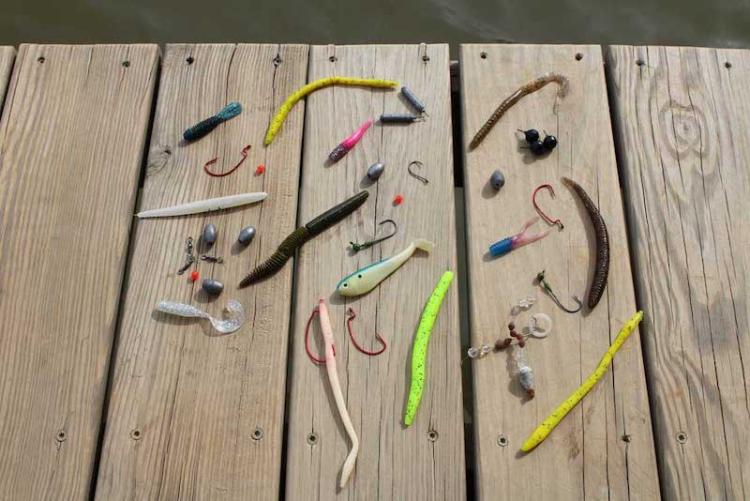Rigging plastic baits for bass fishing has evolved over time, along with tactics and the baits themselves. Let’s take a look at some of the most popular plastic bait rigging strategies that will help you adjust your presentation to be the most life-like and effective offering possible.
TEXAS RIG
Tried and true since the early days of bass fishing, Texas rigging allows the angler to precisely position the bait anywhere, especially in dense vegetation or heavy cover. The Texas rig can be used on virtually any plastic bait with emphasis on being able to firmly hide the hook point in the bait while allowing for maximum hook penetration when a bass latches on to the bait. To ensure a good hookset, push the hook point all the way through the bait, creating a channel in the plastic, then pull the hook point back far enough to cover the point.
CAROLINA RIG
Similarly rigged to the Texas rig, placement of the weight on the Carolina rig should reflect the terrain the angler is fishing. The idea is to allow the weight to maintain contact with the bottom while the bait moves relatively free behind the weight. When fishing submerged vegetation, adjust the leader length so that the bait will be visible at the tops of the grass while the weight bounces along the bottom, but remember, the longer the leader, the more lifelike your bait will appear. When setting the hook on a Carolina-rigged bait, be sure to reel in the slack and feel the fish on the line before striking back. Having slack in the line on the hookset is the most common cause of missed hooksets.
WACKY RIG
The go-to technique for many professional and weekend anglers alike during the pre- and post- spawn season is the wacky rig. Worms or at least worm-like baits top the list of baits to fish wacky rigged and the hook an be singularly impaled through the middle of the bait or double hooked, meaning the bait is hooked down through the middle then turned and hooked again coming back out.
Another alternative is to use a specially made O-ring that encircled the bait, then the hook bend is slipped under the ring rather than the bait. The downside to the double hooked rig is that it can reduce the action of the bait as it falls through the water but in cases where large baits are used, the double hook ensures the hook stays in the bait throughout a particularly vicious strike (which the wacky rig is famous for enticing). The single hook results in more lively action of the bait but the bait will only last for one or two fish, resulting in cycling through a lot of plastic baits. The O-ring tends to reduce the damage to the bait while at the same time imparting the same action of the single hook.
NED RIG
The Ned rig rose to fame because it shines as a finesse bait when conditions are tough or bass become finicky. The rig itself is a lightweight ball or mushroom shaped jig head with an exposed straight shank hook. Nearly all Ned rig baits float, so when impaled on the light weight jig head, the tail rises up with the nose down. The best tip is not to provide much action when fishing the bait. Simply reel it along the bottom with the occasional pause and allow the bait to wiggle along the bottom. This is not a bait to cover a lot of water, but the natural presentation can create bites on days when 5 or 6 good bites is all you can ask for on a tough day.
DROP-SHOT RIG
Another finesse rigging tactic, the drop shot rig is the reverse of the Carolina rig with the weight on the bottom and the hook tied inline 12-24 inches above the weight. Drop shots shine in deep water scenarios when fish are finicky and the angler can position the boat above the fish without spooking them. The number one tip with the drop shot is tying the hook so that it rides correctly. Essentially a Palomar knot with a long tag end, make sure that the tag passes through the side of the hook eye facing the point. This allows the hook to ride upright so that when a fish takes the bait, the hook is positioned to sink into the upper jaw on the hookset.
- Phillip Gentry











